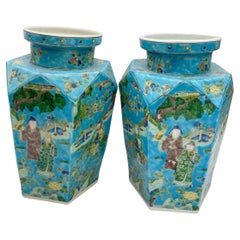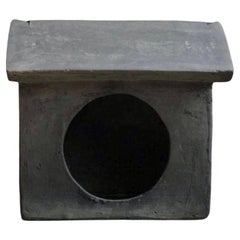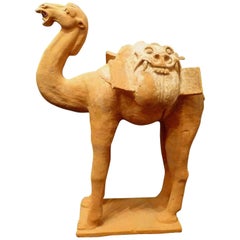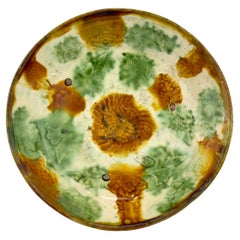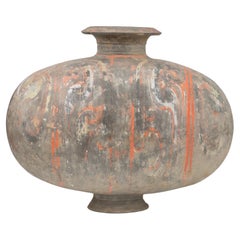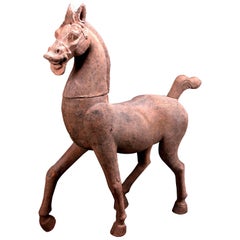Ceramic Antiquities
to
271
285
83
706
3
1
1
1
464
148
94
34
9
7
3
2
1
2
3
3
706
549
497
281
230
669
546
339
146
113
706
706
706
2
1
1
Material: Ceramic
Antique Pair of Chinese Porcelain Vases
Located in Brea, CA
A pair of antique Chinese porcelain vases with very beautiful hand paint. Excellent condition, measures: 12” x 8 '', the mouth of the vase is 5.5'', the bottom of the vase is 6.5, se...
Category
Early 20th Century Chinese Qing Ceramic Antiquities
Materials
Porcelain
Japanese Antique Ceramic Zushi "KAWARA-ZUSHI" 1920-1930s/Object Wabi-sabi Mingei
Located in Iwate-gun Shizukuishi-cho, Iwate Prefecture
Height 21cm, width 23.2cm, depth 16cm.
An early tiled shrine"KAWARA-ZUSHI".
Ceramic shrines were made in pottery producing areas all over the country, but they are rare, and are o...
Category
Early 20th Century Japanese Showa Ceramic Antiquities
Materials
Ceramic
$640 Sale Price
20% Off
Large Superb Naturalistic Modeled Standing Camel, Tang Dynasty Oxford TL Tested
Located in Greenwich, CT
A large superbly and naturalist modeled standing camel, Tang dynasty 618-907, come with Oxford authentication TL test certificate, Oxford test numbers 102s49.
Category
15th Century and Earlier Chinese Tang Antique Ceramic Antiquities
Materials
Terracotta
Sancai-Glazed ‘Floral’ Dish, Liao Dynasty(916~1125)
Located in seoul, KR
Well potted with shallow sides rising from a short foot, the interior molded with a single chrysanthemum surrounded by peony blossoms picked out in amber and with green leaves agains...
Category
15th Century and Earlier Hong Kong Tang Antique Ceramic Antiquities
Materials
Pottery, Stoneware
$3,835 Sale Price
35% Off
Large Cocoon-shaped jar with cloud-scroll design, Han Dynasty
Located in seoul, KR
This jar would have served as a mortuary object (mingqi), placed in a tomb as a substitute for the more valuable bronze and lacquer vessels used in daily life. Along with a variety o...
Category
15th Century and Earlier Hong Kong Han Antique Ceramic Antiquities
Materials
Pottery
$1,813 Sale Price
30% Off
Monumental Han Dynasty Terracotta Horse - TL Tested - China, '206 BC–220 AD'
Located in San Pedro Garza Garcia, Nuevo Leon
A massive pottery horse with separately made head and tail, standing on all fours and striding with its right hoof forward. Extended snout ends in parted lips showing teeth beneath i...
Category
15th Century and Earlier Chinese Han Antique Ceramic Antiquities
Materials
Terracotta
A Large Carved Longquan Celadon Yuhuchunping, Yuan-Ming Dynasty
Located in seoul, KR
The bulbous body is adorned with elegantly carved floral motifs, with intertwining vines and flowers forming a natural, flowing pattern. The base is left unglazed. Base surface crack...
Category
15th Century and Earlier Indonesian Ming Antique Ceramic Antiquities
Materials
Celadon
$9,750 Sale Price
35% Off
Large Pottery Standing Figure of Attendant, Han dynasty
Located in seoul, KR
This artwork, acquired in Hong Kong during the 1990s, is presumed to have been produced in the same kiln from the Han dynasty, based on the head of the Sotheby's reference piece, which also originated from Hong Kong. Furthermore, given its almost identical shape to the piece from the Artemis Gallery...
Category
15th Century and Earlier Hong Kong Han Antique Ceramic Antiquities
Materials
Pottery
$3,213 Sale Price
30% Off
Chinese ceramic Green Glazed 'Shiwan' Opium Pillow, Early 20th Century
Located in Jimbaran, Bali
This Shiwan ceramic pillow of earthenware features a green/blue glaze, which is less common than the distinctive green-glaze of Shiwan ware. Pillows in this shape were not only used by opium smoke...
Category
Early 20th Century Chinese Other Ceramic Antiquities
Materials
Ceramic
Changsha Bowl from Belitung Ship, Tang Dynasty
Located in seoul, KR
The edges have been dipped in four places with brown, probably iron-oxide. The well of the bowl is freely painted in deep green and coffee coloured brown. These are characteristic fe...
Category
15th Century and Earlier Indonesian Tang Antique Ceramic Antiquities
Materials
Pottery
$1,625 Sale Price
35% Off
19th C., A Pair of Antique Japanese Shigaraki Blue Glazed Ceramic Pots 'Hibachi'
Located in Sampantawong, TH
A pair of antique Japanese Shigaraki blue glazed ceramic Hibachi.
Hibachi is a traditional Japanese heating device.
Age: Japan, 19th Century
Size: Height 23 C.M. / Width 24 C.M.
Co...
Category
19th Century Japanese Antique Ceramic Antiquities
Materials
Ceramic
$1,560 Sale Price / set
20% Off
Blue And White Kraak Plate, Late Ming Dynasty
Located in seoul, KR
A Chinese blue and white Kraak plate, the central roundel depicting birds and floral design in a waterside, the rim with panels enclosing foliage and decorative objects.
Period: Late Ming-Early Qing Dynasty (17th century)
Type: Blue and White Porcelain
Provenance : Acquired early 2000s from Southeast asia(Probably from Shipwreck)
Reference :
1) Sotheby's London 12 November 2019 - STYLE: Private Collections - Lot 12
(Price range : 3,000GBP-5,000GBP / Type : Closely related)
2) Christies NEW YORK - 1–11 MAY 2018 - THE COLLECTION OF PEGGY AND DAVID ROCKEFELLER: ONLINE SALE - Lot 1405
(Price realised : 5,625 USD / Type : Highly related)
* Kraak
Kraak porcelain is a type of Chinese export porcelain that was produced during the late Ming Dynasty, especially during the reign of the Wanli Emperor (1573-1620). It is famous for its distinctive design and style. Kraak ware...
Category
17th Century Indonesian Ming Antique Ceramic Antiquities
Materials
Ceramic, Porcelain
$1,495 Sale Price
50% Off
Antique Qing Dynasty Blue and White Chinese Porcelain Censer
Located in Brea, CA
Qing dynasty Kang XI blue and white Chinese porcelain censer with a design of "Antiques" and auspicious objects, the base in clear glaze and the mouth...
Category
Early 18th Century Chinese Qing Antique Ceramic Antiquities
Materials
Porcelain
2 Pairs of Antique Chinese Orange and White Design Porcelain Ginger Jars
Located in Queens, NY
2 PAIRS of Antique Chinese (late 19th-early 20th Century) porcelain ginger jars with intricate orange and white designs and matching lids. (PRICED PER PAIR)
Condition: Good; Wear co...
Category
19th Century Chinese Chinese Export Antique Ceramic Antiquities
Materials
Porcelain
Rare annamese cream glazed ewer, Vietnam, 11-15th century
Located in seoul, KR
Famous annamese cream glazed ceramic ewer covered with a cream glaze. Traces of excavation are clearly visible in the glaze.
Dates : Presumably Ly Dynasty (11-13th century)
Region ...
Category
15th Century and Earlier Vietnamese Antique Ceramic Antiquities
Materials
Ceramic, Stoneware
Mid-century hand-lacquered plate with zodiac signs from Myanmar
Located in Oostende, BE
Mid-century hand-lacquered plate with zodiac signs from Myanmar
Category
Mid-20th Century Burmese Ceramic Antiquities
Materials
Stoneware
Two Cosmetic Box and a Square Box from Ca Mau Ship, Qing Dynasty, Yongzheng Era
Located in seoul, KR
1. Left Round Cosmetic Box : Circular form with flattened doomed cover, the covers with a medallion of simple stylised flowers surrounded by stylised lapp...
Category
Early 18th Century Vietnamese Qing Antique Ceramic Antiquities
Materials
Ceramic
$1,625 Sale Price / set
35% Off
Three Annamese Small Jars with bird design, 15th century, Le Dynasty
Located in seoul, KR
Vietnamese stoneware jar with representative bird designs. These pieces exhibit a relatively vivid and clear color compared to similar works from Hoi An hoard. The main feature of th...
Category
15th Century and Earlier Vietnamese Antique Ceramic Antiquities
Materials
Stoneware
$1,813 Sale Price
30% Off
Elegant Han Dynasty Terracotta Warrior - China '206 BC - 220 AD'
Located in San Pedro Garza Garcia, Nuevo Leon
Impressive terracotta warrior representing a banner bearer gripping a wooden staff with his hands (dematerialized through the ages); his gaze is ser...
Category
15th Century and Earlier Chinese Han Antique Ceramic Antiquities
Materials
Terracotta
Cizhou slender meiping, Yuan Dynasty
Located in seoul, KR
The elongated body is fluidly painted in brown on a white slip and under a clear glaze with a broad band of abstract floral scroll between a band of upright petals below and further ...
Category
15th Century and Earlier Hong Kong Other Antique Ceramic Antiquities
Materials
Stoneware
$7,996 Sale Price
60% Off
Set of Five Chinese Sancai Female Attendant Figures
Located in Chicago, IL
Molded of earthenware, this set of five petite sculptures are a type of centuries-old burial figurine known as míngqì. Such model figures were placed in tombs of individuals with high status to ensure a safe journey to the afterlife. Meant to depict the pleasures of daily life, common burial figures...
Category
15th Century and Earlier Chinese Antique Ceramic Antiquities
Materials
Ceramic
18th Century Antique Pair of Chinese Blue and White Porcelain Jars and Covers
Located in Brea, CA
Qing Dynasty pair of antique 18th century Chinese blue and white porcelain jars and covers, 2 of five sacrificial utensil...
Category
Late 18th Century Chinese Qing Antique Ceramic Antiquities
Materials
Porcelain
Japanese Antique Ceramic Zushi "KAWARA-ZUSHI" 1920-1930s/Object Wabi-sabi Mingei
Located in Iwate-gun Shizukuishi-cho, Iwate Prefecture
An early tiled shrine"KAWARA-ZUSHI".
Ceramic shrines were made in pottery producing areas all over the country, but they are rare, and are only made in Okayama today.
It is thought ...
Category
Early 20th Century Japanese Showa Ceramic Antiquities
Materials
Ceramic
Pair of Japanese Satsuma Plates, 19th Century
Located in New York, NY
wooden stands shown in pictures are included with these items; each plate is decorated in gilt and various colored enamels; portraying a scene of enlightened beings; approximate meas...
Category
Late 19th Century Japanese Antique Ceramic Antiquities
Materials
Porcelain
Three Annamese Small Blue Lidded Boxes, 15th century, Le Dynasty
Located in seoul, KR
These are three small lidded boxes from the Vietnamese period, specifically from the 15th century during the Le Dynasty.
Dates : 15th century Le Dynasty
Region : North Annam, Viet...
Category
15th Century and Earlier Vietnamese Antique Ceramic Antiquities
Materials
Ceramic
$954 Sale Price / set
40% Off
Large Block Print Blue and White Bowl c 1822, Tek Sing Cargo
Located in seoul, KR
This impressive, large-sized circular bowl, featuring hues of blue and white, showcases decoration through a block print technique. It is adorned with two horizontal bands of shou ch...
Category
1820s Indonesian Antique Ceramic Antiquities
Materials
Porcelain
Pair of Antique Chinese Floral and Bird Patterned Porcelain Lidded Ginger Jars
Located in Queens, NY
PAIR of Antique Chinese (late 19th-early 20th Century) porcelain lidded ginger jars with a pattern featuring sprawling tree branches and foliage in greens, oranges, and browns, and ...
Category
19th Century Chinese Chinese Export Antique Ceramic Antiquities
Materials
Porcelain
Ancient Gu Shape 'Canal Houses' Vase, Qing Dynasty, Kangxi Era, Circa 1690
Located in seoul, KR
This vase is decorated with dutch canal houses on one side and Chinese pagodas and flowers on the other side. Eastern and Western motifs were simultaneously expressed in ceramics.
Period : Qing Dynasty, Kangxi Period
Production Date : 1690-1699
Made in : Jingdezhen
Destination : Netherland
Found/Acquired : Southeast Asia , South China Sea, Vung Tau...
Category
1690s Vietnamese Chinoiserie Antique Ceramic Antiquities
Materials
Ceramic
$3,893 Sale Price
35% Off
18th Century Blue and White Chinese Nanking Cargo and Cafe-au-lai Porcelain Bowl
Located in Brea, CA
An 18th century Chinese Nanking cargo blue and white and cafe -au-lait porcelain bowl, decorated to the interior with sprays of flowers and leaves, with ...
Category
Mid-18th Century Chinese Qing Antique Ceramic Antiquities
Materials
Porcelain
Antique Japanese Meiji Period Set Of Cups or Tea Bowls Porcelain Landscape
Located in Amsterdam, Noord Holland
A very nice set of bowls with and lids. Very nicely decorated with a landscape scene.
They lids are marked.
Condition
1 of the lid has 2 or 3 small frits, rest perfect. Dishes perf...
Category
19th Century Japanese Meiji Antique Ceramic Antiquities
Materials
Porcelain
Celadon Vase, Five Dynasties or Northern Song dynasty, 10th-11th Century
Located in seoul, KR
The form of Longquan celadon vases from the Northern Song dynasty evolved from an early design with a long neck and tapering body to a later ovoid body with a shorter neck. Over time, the glaze developed a more olive tone, and the carved decorations became more pronounced and intricate. Examples of such vases include one without a cover dated to the Yuanfeng era (1078~1085) and documented in literature, and another similar vase without loop handles preserved by the Qingyuan County Cultural Relics Bureau. An earlier example featuring loop handles and a lotus-like cover is also mentioned in historical texts.
The use of Longquan covered vases, especially as funerary jars for offerings like wine and grains, was highlighted by an inscription on a piece from the Sir Percival David Collection, London. This inscription wishes for the vessel to preserve fragrant wine for centuries, blessing the owner with prosperity, longevity, and a vast lineage, dated to the third year of the Yuanfeng period (1080). This practice was common in the regions of Southern Zhejiang and Northern Fujian. A similar celadon vase from the Linyushanren collection was auctioned at Christie’s Hong Kong, emphasizing the cultural and historical significance of these artifacts.
Period : Five Dynasties or Northern Song Dynasty
Type : Celadon, Zhejiang province
Medium : Celadon
Size : 31.5 cm(Height) x 11.5(Diameter)
Provenance : Acquired in late 1990s from Hongkong
Reference :
1) The British Museum image id - 01613270570
2) Christies New York 23–24 MAR 2023 - Important Chinese Ceramics and Works of Art - Lot 1012
(Price Range : USD 18,000 – USD 25,000 / Type : Related)
3) National Gallery of Victoria - Accession Number - AS5-1973
* Celadon from Five Dynasties (907~960) to the early Northern Song Dynasty (960~1127)
The period from the Five Dynasties (907~960) to the early Northern Song Dynasty (960~1127) marked a significant transitional phase in the development of Chinese celadon ceramics...
Category
15th Century and Earlier Hong Kong Antique Ceramic Antiquities
Materials
Celadon
$3,960 Sale Price
60% Off
Two Yixing Teapots and Covers
Located in seoul, KR
Both Yixing Zisha teapots appear to be modern-Republic era pieces. Yixing Zisha teapots are made from rare Zisha (紫砂) clay, which is exclusively mi...
Category
20th Century East Asian Ceramic Antiquities
Materials
Pottery
$975 Sale Price / set
35% Off
A Rare 'Yue' Celadon Glazed Octagonal Vase, Western Jin Dynasty (266 - 316 AD)
Located in seoul, KR
Finely potted with incurved facetted sides divided by raised ribs and set with two short lugs to the shoulder, the body rising to a short octagonal neck, the domed cover of conforming section, surrounded by an upturned rim and surmounted by a bud finial, applied overall with a celadon glaze of the period.
A related vase of this rare and charming form, in the Zhenjiang Museum, Zhenjiang, is illustrated in the Complete Collection of Chinese Ceramics. Song, vol. 8, Shanghai, 1999, pl. 52. Vases of related octagonal shape were produced at the Ding kilns, in Hebei province, and the qingbai kilns in Jiangxi province; see a Ding vase in the Palace Museum, Beijing, illustrated in Selection of Ding Ware. The Palace Museum’s Collection and Archaeological Excavation, Beijing, 2002, pl. 37; and a qingbai example, from the Meiyintang collection, illustrated in Regina Krahl, Chinese Ceramics from the Meiyintang Collection, vol. 3 (II), London, 2006, pl. 1590; and another carved with a floral scroll, included in the exhibition Song Ceramics from the Kwan Collection, Hong Kong Museum of Art, Hong Kong, 1994, cat. no. 105.
Period : Western Jin Dynasty (266 - 316 AD)
Type : Octagonal Vase
Medium : Yue celadon...
Category
15th Century and Earlier Hong Kong Han Antique Ceramic Antiquities
Materials
Celadon
$19,975 Sale Price
75% Off
Stunning Terracotta Standing Horse, Tang Dynasty, China '618-907 AD', TL Test
Located in San Pedro Garza Garcia, Nuevo Leon
Magnificent standing horse in orange terracotta and traces of painting. With a finely decorated saddle and with the mane and tail hair braided. TL Test by Ralph Kotalla Lab NE: 09K12...
Category
15th Century and Earlier Chinese Tang Antique Ceramic Antiquities
Materials
Terracotta
A Molded Longquan Celadon 'Fu Shou' Ewer, Ming Dynasty
Located in seoul, KR
One side of the vase showcases a panel with the Shou character at its center, symbolizing longevity, while the opposite side displays the Fu character, signifying luck. The neck of the vase is adorned with leaves. There are similar types and decoration but varying in shape, resembling a pear, all from the same era and crafted in celadon, often referred to as 'fu shou' vases.
Period: Yuan-Ming Dynasty (1271-1644)
Region: Longquan, China
Medium: Celadon
Type: Ewer
Provenance : Acquired in late 1990s from Hongkong
Reference
1) British Museum - Museum number 1931,1118.5
(Type : Closely related)
2) Christies NEW YORK 24–25 MAR 2022 - Important Chinese Ceramics and Works of Art - Lot 1105
(Price realised : 9,450 USD / Type : Related)
3) Sotheby's New York 19 March 2024 - Chinese Art - Lot 172
(Price range : 15,000 USD - 20,000 USD / Type : Related)
* Ming Dynasty Longquan Celadon
Longquan celadon from the Ming Dynasty typically exhibits a more robust and heavier stoneware body compared to its Song Dynasty predecessors. The Ming era saw an evolution in celadon glaze, achieving a wider spectrum of green hues, from olive to bluish-greens. Ming celadons...
Category
15th Century and Earlier Hong Kong Ming Antique Ceramic Antiquities
Materials
Celadon
$1,995 Sale Price
50% Off
Rare 19th Century Chinese Porcelain Brush Pot for Vietnam
Located in MEAUX, FR
Rare 19th Century Chinese Porcelain Brush Pot for Vietnam, Enhanced with 22k Gold Kintsugi Restoration
Immerse yourself in the history and elegance of this rare Chinese porcelain...
Category
19th Century Chinese Antique Ceramic Antiquities
Materials
Porcelain
Chinese Song Period Celadon Glazed Bowl
Located in London, GB
A Chinese Song period celadon glazed bow, with hand-carved decoration to the interior.
Really nicely thinly potted example with craquelure due to age.
P...
Category
15th Century and Earlier Archaistic Antique Ceramic Antiquities
Materials
Pottery, Stoneware
Antique Chinese Ceramic Headrests 'Opium Pillow', Early 20th Century, Pair
Located in Jimbaran, Bali
This pair of Chinese ceramic headrests feature a green, brown and blue glaze as well as floral motifs. They also feature pierced sides with sy...
Category
Early 20th Century Chinese Qing Ceramic Antiquities
Materials
Ceramic
Porcelain with transparent pale-bluish (qingbai-type) glaze, Yuan Dynasty
Located in seoul, KR
This piece is shaped like a lotus bud, featuring a gracefully undulating body and intricate geometric patterns. The neck is adorned with finely incised dense lines, adding visual var...
Category
15th Century and Earlier Hong Kong Antique Ceramic Antiquities
Materials
Ceramic, Porcelain
$1,225 Sale Price
30% Off
Japanese Antique Tsubo pot Flower Vase Wabi-Sabi
Located in Chiba, Chiba
This is an old Japanese vase.
It is old but in good condition with no cracks or chips.
We will always suggest the best shipping method.
Please contact us first.
We also introduce m...
Category
19th Century Japanese Antique Ceramic Antiquities
Materials
Pottery
14th-16th Century, Sukhothai, Antique Sukhothai Pottery Jar from Shipwreck
Located in Sampantawong, TH
Sukhothai pottery jar from shipwreck.
Age: Thailand, Sukhothai Period, 14th - 16th Century
Size: Height 27 C.M. / Width 21 C.M.
Condition: Nice condition overall (some expected degr...
Category
15th Century and Earlier Thai Antique Ceramic Antiquities
Materials
Pottery
$680 Sale Price
20% Off
Pair of Chinese Porcelain Cover Vases, Early 19th Century
Located in New York, NY
decorated with figural scenes amongst foliage
Category
Early 19th Century Chinese Antique Ceramic Antiquities
Materials
Porcelain
Chinese Five-Tied Emperor Cloisonne Vase from the Republic Period
Located in San Diego, CA
Smooth finish Chinese cloisonne dragon (5 toed Emperor) vase, circa 1930s (Republic). The piece is 9" high in an attractive aqua blue finish w...
Category
Early 20th Century Chinese Ceramic Antiquities
Materials
Ceramic
$675 Sale Price
28% Off
China 549-577 AD Northern Qi Dynasty Ancient Caparisoned Horse In Earthenware
Located in Miami, FL
Exceedingly rare Chinese pottery caparisoned horse from the Northern Qi region.
A beautiful sculptural piece, created in China during the Northern Qi dynasty period, between the 549 and 577 AD. This horse statue is extremely finely modeled of earthenware pottery, standing in a very elegant and majestic position striding on a trapezoidal shaped base.
The animal has a gracefully arched neck to the left and its extremely well modeled. The head is adorned with a large detailed tassels of plumes and the body is embellished with a beautiful saddle and intricate harnesses. The trapping around the chest and rump is adorned with elaborated tassels and the straps are accented with multiples florets and bosses in high relief.
The surface is treated with applications of natural pigments such; red, white and others.
Has a measurements of 394 mm by 343 mm by 257 mm (15.53 x 13.52 x 10.15 Inches) (39.4 x 34.3 x 25.7 Cm).
Northern Qi, was the successor state of the Chinese Xianbei state of Eastern Wei...
Category
15th Century and Earlier Chinese Archaistic Antique Ceramic Antiquities
Materials
Earthenware, Pottery
$31,988 Sale Price
20% Off
Hu vase with green glaze, Han Dynasty
Located in seoul, KR
It is made from a fairly high-fired reddish pottery and coated in a particularly attractive glossy thick streaky green and finely-crackled glaze, the colour of which varies according...
Category
15th Century and Earlier Hong Kong Han Antique Ceramic Antiquities
Materials
Stoneware
$2,992 Sale Price
25% Off
Chinese White and Blue Octagonal Porcelain Pot
Located in Queens, NY
Chinese white and blue porcelain octagonal pot painted with a unique figurative vignette in each panel beneath a floral design leading up to the opening.
Condition: Good; Wear consi...
Category
20th Century Chinese Chinese Export Ceramic Antiquities
Materials
Porcelain
A Molded Qingbai 'Flowers' Dish, Southern Song Dynasty
Located in seoul, KR
The plate depicted here exhibits the intricate floral patterns and lotus motifs that are typical of Southern Song designs. The central floral motif captures the essence of Oriental b...
Category
15th Century and Earlier Hong Kong Antique Ceramic Antiquities
Materials
Ceramic
$1,560 Sale Price
60% Off
A Zhejiang Porcelain Ewer, Northern Song Dynasty
Located in seoul, KR
The oviform body is divided into few lobes. All covered in a finely crackled pale olive-green glaze. The surface and glaze characteristics are definitive, confirming the authenticity...
Category
15th Century and Earlier Hong Kong Antique Ceramic Antiquities
Materials
Porcelain
$2,925 Sale Price
35% Off
Rare Longquan Celadon Tripod Incense Burner, Song-Yuan Dynasty
Located in seoul, KR
The vessel features a compressed body supported by three tapered feet and a flat, outwardly flaring rim. Three slender flanges originate from a subtle ridge on the shoulder and exten...
Category
15th Century and Earlier Hong Kong Antique Ceramic Antiquities
Materials
Celadon
$17,500 Sale Price
50% Off
Large Changsha Bowl from Belitung Ship, Tang Dynasty
Located in seoul, KR
The edges have been dipped in four places with brown, probably iron-oxide. The well of the bowl is freely painted in deep green and coffee coloured brown. These are characteristic fe...
Category
15th Century and Earlier Indonesian Tang Antique Ceramic Antiquities
Materials
Pottery
$2,800 Sale Price
30% Off
Rare Yue Celadon Chicken-Head Ewer, Jin-Southern Dynasty
Located in seoul, KR
Chicken-head ewers are among the most distinct and emblematic pottery pieces from the Han (206 BC ~ AD 220) to the Tang dynasties. Their production commenced during the Jin dynasty i...
Category
15th Century and Earlier Hong Kong Han Antique Ceramic Antiquities
Materials
Pottery
$6,950 Sale Price
50% Off
A Grey Pottery Figure of Boar(Wild Pig), Han Dynasty
Located in seoul, KR
This piece is an ancient terracotta animal sculpture in the form of a pig, rendered in a simple yet vivid manner. The pig stands firmly on four stout legs, with a short and solidly m...
Category
15th Century and Earlier Hong Kong Han Antique Ceramic Antiquities
Materials
Pottery
$2,700 Sale Price
40% Off
6 Elegant Ming Dynasty Court Attendants in Glazed Terracotta, China 1368-1644 AD
Located in San Pedro Garza Garcia, Nuevo Leon
A fine set of a six court attendants as in the Forbidden City of Beijing, elegantly dressed in a Green & Red Daopao – a traditional men’s formal attire from the Ming Dynasty dated 1368-1643 A.D. – with glazed robes and Red Pigment remains in their hat and belts. They stand in an honorary posture atop a red plinth, some with orifices in their hands, where spirit objects were placed to comfort or satisfy the deceased. The heads are detachable, as often seen on the larger figures from this period.
They are accompanied by a Certificate of Authenticity, and Certificate of Expertise by Jean-Yves Nathan - a leading authority specialized in Far East Archaeology from the CEDEA (The European Confederation of Art Experts).
Burial figurines of graceful dancers, mystical beasts, and everyday objects reveal both how people in early China approached death and how they lived. Since people viewed the afterlife as an extension of worldly life, these figurines, called mingqi, sometimes referred as “spirit utensils” or “vessels of ghosts” disclose details of routine existence and provide insights into belief systems over a thousand-year period.
The Ming dynasty was the ruling dynasty of China – then known as the Empire of the Great Ming – for 276 years (1368–1644 AD). Founded by Chu Yuan-chang, the rebel leader that was successful in removing the mongols from the throne. Chinese control was re-asserted in China and eastern Asia. Literature became more important, schools were created, and the justice system was reformed. The Ming dynasty is described by some as "one of the greatest eras of orderly government and social stability in human history,” was the last imperial dynasty in China ruled by ethnic Han Chinese.
The practice of burying ceramic objects with the deceased went into decline from the 10th to the 14th Century AD. There was a revival in placing miniature representations of glazed terracotta objects such a furniture, food offerings, horses, miniature statues...
Category
15th Century and Earlier Chinese Ming Antique Ceramic Antiquities
Materials
Terracotta
Vintage Persian Bird Lotus Tile Scene Colorful Decor Backsplash Set 6
Located in Hyattsville, MD
Six large 20th century hand painted Persian tiles. Siliceous paste painted in polychromy under transparent colorless glaze. Each tile is 8 by...
Category
Mid-20th Century Persian Islamic Ceramic Antiquities
Materials
Ceramic
$2,000 Sale Price
76% Off
A Large and Rare Straw-Glazed Pottery Amphora, Tang Dynasty
Located in seoul, KR
The ovoid shape suggests the influence from “amphora” of Greece and Rome, while the dragon-shaped handles allude to Persian and Central Asian metalwork. The ubiquitous dragon is a Ea...
Category
15th Century and Earlier Hong Kong Tang Antique Ceramic Antiquities
Materials
Pottery, Stoneware
$8,125 Sale Price
35% Off
Han Dynasty, Antique Chinese Pottery Bowl Support By Three Legs
Located in Sampantawong, TH
Chinese pottery bowl support by three legs.
Age: Chinese, Han Dynasty, B.C. 206 - A.D. 220
Size: Diameter 23.7 C.M. / Thickness 11.7 C.M.
Condition: Well-preserved old burial condit...
Category
15th Century and Earlier Chinese Antique Ceramic Antiquities
Materials
Pottery
$880 Sale Price
20% Off
Hirado Porcelain Koro Censer Meiji Dynasty
By Hirado
Located in Mérida, YU
This is an original Japanese Antique Porcelain Hirado Koro Censer circa 1850-1890 Meiji Dynasty.
In perfect condition.
Museum
Category
Late 19th Century Japanese Japonisme Antique Ceramic Antiquities
Materials
Porcelain
Green-Glazed Dish, Han Dynasty
Located in seoul, KR
This Han Dynasty green-glazed dish exhibits significant signs of wear, indicative of its age and the long passage of time it has witnessed. The glaze, once vibrant, now shows substan...
Category
15th Century and Earlier Hong Kong Han Antique Ceramic Antiquities
Materials
Earthenware
Cizhou Baluster Jar, Yuan-Ming Dynasty
Located in seoul, KR
The vase features a broad, rounded body with a slightly flared neck and a pedestal base. The decoration consists of intricate brushwork in iron-brown pigment, depicting figures and s...
Category
15th Century and Earlier Hong Kong Antique Ceramic Antiquities
Materials
Pottery
$2,995 Sale Price
24% Off
Yue Celadon Ewer, Late Tang-Northern Song Dynasty
Located in seoul, KR
This Yue ware celadon ewer features a gracefully rounded body that expands smoothly, complemented by a wide, flaring mouth. The translucent olive-green glaze envelops the surface, en...
Category
15th Century and Earlier Hong Kong Tang Antique Ceramic Antiquities
Materials
Celadon
$3,150 Sale Price
30% Off
Recently Viewed
View AllMore Ways To Browse
Large Chinese Celadon Pots
Antique Slingshot
Bactrian Idol
Gandharan Schist
Geisha Pillow
Han Dynasty Bowl
Khmer Torso
Ancient Luristan Bronze
Chinese Terracotta Army Warriors
Cloisonne Pots Bonsai Trees
Greco Bactrian
Han Dynasty Amphora
Han Dynasty Court Lady
Palanquin Handles
Sancai Phoenix
Schist Gandharan Buddha
Bactrian Stone
Chinese Coconut Cup
